Related Research Articles
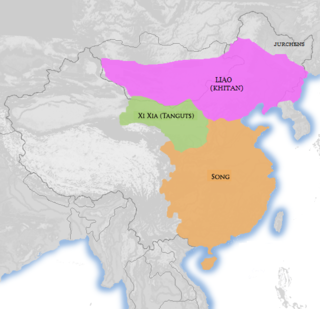
The Western Xia or the Xi Xia (Chinese: 西夏; pinyin: Xī Xià; Wade–Giles: Hsi1 Hsia4), officially the Great Xia (大夏; Dà Xià; Ta4 Hsia4), also known as the Tangut Empire, and known as Mi-nyak to the Tanguts and Tibetans, was a Tangut-led Buddhist imperial dynasty of China that existed from 1038 to 1227. At its peak, the dynasty ruled over modern-day northwestern China, including parts of Ningxia, Gansu, eastern Qinghai, northern Shaanxi, northeastern Xinjiang, and southwest Inner Mongolia, and southernmost Outer Mongolia, measuring about 800,000 square kilometres (310,000 square miles).
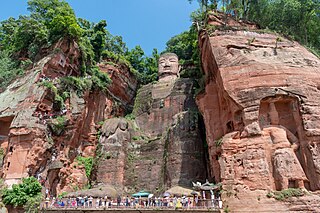
Sichuan is a province in Southwest China occupying most of the Sichuan Basin and the easternmost part of the Tibetan Plateau between the Jinsha River on the west, the Daba Mountains in the north and the Yungui Plateau to the south. Sichuan's capital city is Chengdu. The population of Sichuan stands at 83 million. Sichuan neighbors are Qinghai to the northwest, Gansu to the north, Shaanxi to the northeast, Chongqing to the east, Guizhou to the southeast, Yunnan to the south, and the Tibet Autonomous Region to the west.
This is a list of historical capitals of China.

The Hongwu Emperor, also known by his temple name as the Emperor Taizu of Ming (明太祖), personal name Zhu Yuanzhang, courtesy name Guorui, was the founding emperor of the Ming dynasty, reigning from 1368 to 1398.

Ming Yuzhen was a peasant rebel leader who established the dynasty of Ming Xia during the late Yuan dynasty in China.
Taizu is a temple name typically, but not always, used for Chinese monarchs who founded a particular dynasty, may refer to:
The Six Arts formed the basis of education in ancient Chinese culture. These were made and practiced by the Confucians.

Dazhou is a prefecture-level city in the northeast corner of Sichuan province, China, bordering Shaanxi to the north and Chongqing to the east and south. As of 2020 census, Dazhou was home to 5,385,422 inhabitants whom 1,850,869 lived in the built-up area made of 2 urban districts.
Lan Yu was a Chinese military general and official who contributed to the founding of the Ming dynasty. His ancestral home was in present-day Dingyuan County, Anhui. In 1393, Lan was accused of plotting a rebellion and put to death by the Hongwu Emperor. About 15,000 people were implicated in the case and executed as part of the Four Major Cases of the early Ming dynasty.

The Red Turban Rebellions were uprisings against the Yuan dynasty between 1351 and 1368, eventually leading to its collapse. Remnants of the Yuan imperial court retreated northwards and is thereafter known as the Northern Yuan in historiography.
Basalawarmi, commonly known by his hereditary noble title, the Prince of Liang, was a Yuan dynasty prince and loyalist who fought against the Ming dynasty. He was a descendant of Khökhechi, the fifth son of Kublai Khan. After the Ming took over Yunnan, the Hongwu Emperor exiled Basalawarmi's family to Korea.
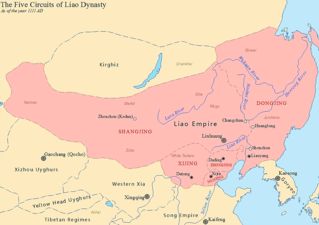
The Liao dynasty, also known as the Khitan Empire, officially the Great Liao, was an imperial dynasty of China that existed between 916 and 1125, ruled by the Yelü clan of the Khitan people. Founded around the time of the collapse of the Tang dynasty, at its greatest extent it ruled over Northeast China, the Mongolian Plateau, the northern part of the Korean Peninsula, southern portions of the Russian Far East, and the northern tip of the North China Plain.
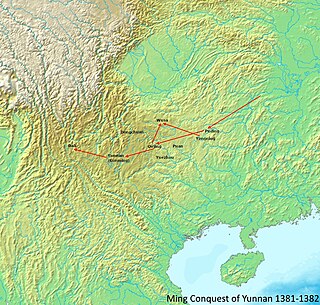
The Ming conquest of Yunnan was the final phase in the Ming dynasty expulsion of Mongol-led Yuan dynasty rule from China proper in the 1380s.
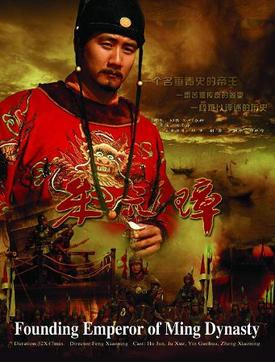
Founding Emperor of Ming Dynasty is a Chinese television series based on the life of Zhu Yuanzhang, the founding emperor of the Ming dynasty. Directed by Feng Xiaoning and starring Hu Jun as the Hongwu emperor, the series was first aired on CCTV in China in 2006.

Chuanqi Huangdi Zhu Yuanzhang is a Chinese television series based on the life of Zhu Yuanzhang, the founding emperor of the Ming dynasty. Starring Chen Baoguo as the emperor, the series was first broadcast on CCTV in mainland China in 2006.
The Ming campaign against the Uriankhai, or the Battle of Jinshan, was a 1387 offensive military expedition of the Ming dynasty's army led by General Feng Sheng against the Uriankhai horde of the Mongol chieftain Naghachu in Manchuria, which was under Liaoyang province of the former Yuan dynasty. It concluded with the surrender of the Uriankhai to the Ming which then controlled Manchuria.
Yeonan Myeong clan is one of the Korean clans. Their Bon-gwan is in Yonan County, Hwanghae Province.

The Ming Xia, officially the Great Xia, was a short-lived Chinese dynasty in modern Sichuan and Chongqing during the chaotic late Yuan dynasty. It was founded by the Red Turban rebel general Ming Yuzhen whose army expelled Yuan loyalists from the region in the late 1350s.

Tang He, courtesy name Dingchen, was a significant character in the rebellion that ended the Yuan dynasty and was one of the founding generals of Ming dynasty. He came from the same village as Zhu Yuanzhang and joined Guo Zixing's Red Turban Rebellion, a millenarian sect related to the White Lotus Society, at the time of its original uprising, in March 1352. Tang was promoted quickly in rank as Guo's army grew. After conquering Jiqing City and Zhenjiang City, which was under the command of Zhu Yuanzhang, he was promoted to Yuan Shuai, and after conquering Changzhou in April 1357, Tang was placed in command there with the rank of deputy assistant chief of the commission of military affairs. In 1367, he was sent south to defeat Fang Guozhen's and Chen Youding's forces, and then campaigned in Shanxi, Gansu, and Ningxia under the command of Xu Da. He was granted the title Duke Xingguo. Tang He died in August 1395, one of the few founding generals of the Ming dynasty who had a natural death.
Liu Futong was a leader in the Red Turban Rebellion during the late Yuan dynasty of China. He had a major presence in northern China and was killed by Zhang Shicheng in 1363.
References
Citations
- ↑ Mote & Twitchett 1988, p. 94.
- ↑ Mote & Twitchett 1988, p. 98.
- 1 2 3 4 5 6 Goodrich & Fang 1976, p. 1072.
- 1 2 3 4 5 6 7 Mote & Twitchett 1988, pp. 100–101.
- 1 2 3 4 5 6 7 8 Mote & Twitchett 1988, pp. 125–127.
- ↑ Taylor 1975, p. 68.
- 1 2 Taylor 1975, pp. 69–70.
- 1 2 3 Taylor 1975, pp. 70=72.
- ↑ Goodrich & Fang 1976, p. 1073.
Books
- Taylor, Romeyn (1975). Basic Annals of Ming T'ai-tsu. Chinese Material and Research Aids Service Center, Inc. ASIN B076VFSKS1.
- Mote, Frederick; Twitchett, Denis (1988). The Cambridge History of China Volume 7 The Ming Dynasty, 1368-1644, Part I. Cambridge University Press. ISBN 978-0-521-24332-2.
- Goodrich, Luther; Fang, Chaoying (1976). Dictionary of Ming Biography 1368-1644 Volume 2. Columbia University Press. ISBN 9780231038331.